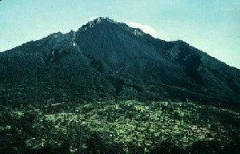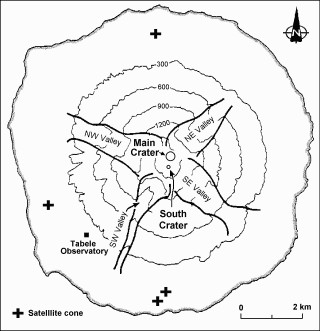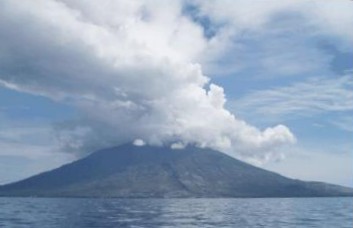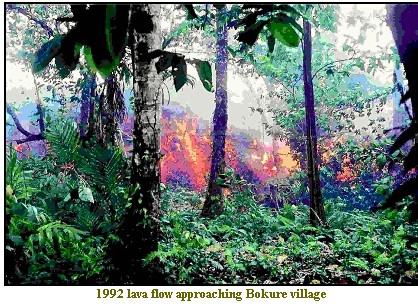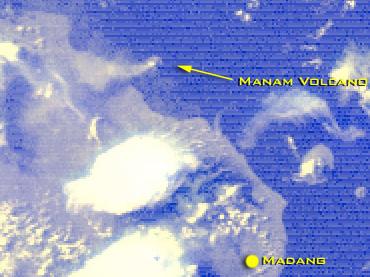|
Monday, December 20th, 2004
As of the 20th of December, the Rabaul Volcanological Observatory
RVO) reported that the alert level has been increased to 3 (out
of 4) at Manam volcano after a large eruption of ash occurred
on Sunday 19th December. Ash was calculated to have reached an
altitude of 50,000 ft, and drifted 250 nautical miles WSW
of Manam. The ash cloud dissipated after about 12 hours. This
sequence of events indicates that Manam volcano is still dangerous,
and there is a possibility of continued large eruptions which
threatens the safety of anyone still on the island. The aviation
colour code is red, indicating the volcano is currently erupting.
Wednesday, December 15th, 2004
Period of activity: 14th (08:00 a.m.) - 15th (08:00 a.m.)
December 2004
Main Crater released forceful emissions of moderate dark grey
ash clouds. The ash plume rose several
hundred meters above the summit and drifted to the east and northeast
resulting in light ash on the east and northeast part of the island,
including Warisi village. Occasional sub-continuous weak roaring
and rumbling noises were heard. At night weak to bright fluctuating
glow was visible. Weak projections of glowing lava fragments occurred
at long intervals.
Southern Crater released thin volumes of whitish
vapour. Occasionally very weak roaring and rumbling noises were
heard. At night steady weak glow was visible. Weak projections
of glowing lava fragments also occurred from Southern Crater at
long intervals.
Sunday, December 12th, 2004
Moderate eruptive activity commenced from the Main Crater
early this morning at 03:00 a.m.
The eruptive activity at the Main Crater changed
to strombolian-type
eruption early this
morning at about 03:00 a.m. The activity was characterised by
continuous projections of
glowing lava fragments that rose some hundred meters above the
summit crater and sub-
continuous weak to loud roaring and rumbling noises. A further
increase was noted at about
06:30 a.m. when sub-continuous emissions of pale to dark-grey
ash clouds became forceful.
Occasional weak roaring and rumbling noises like 'jet engines'
also became pronounced.
Very fine light ash fell at Warisi village.
Weak fluctuating glow and occasional weak projections
of glowing lava fragments were
observed from the Southern Crater at long intervals. Audible noises
consisting of weak roaring
and rumbling noises were also heard at long intervals. At daybreak
puffs of thin light brown
ash emissions were visible. There was slight increase in seismicity.
Activity was at high level.
Volcanic
tremors were recorded. RVO
Friday, December 10th, 2004
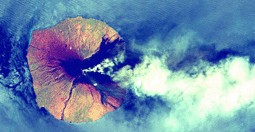 NASA
Space photo from around Dec. 1st. 2004
NASA
Space photo from around Dec. 1st. 2004 |
Dark smoke and ash is still coming from the main
crater, a column rises few hundred meters.
South crater now emitting white smoke, but still glowing at night.
The trend of eruptive activity since the strong strombolian to
sub-plinian eruption on 23rd November has been low to moderate.
Furthermore during the past few days the trend has been showing
a slow steady decline. Subsequently, it is recommended that the
alert level be downgraded to Stage 2.
Monday, December 6th, 2004
 Manam
Islanders boading the Motuan Chief in the evacuation exercise.
© Nationalpic by BONNEY BONSELLA
Manam
Islanders boading the Motuan Chief in the evacuation exercise.
© Nationalpic by BONNEY BONSELLA |
THE volcanic eruption on Manam Island
in the Madang province has so far claimed five lives –
two elderly women and three children between the ages of 5-13.
The coordinator of the Manam evacuation exercise confirmed the
deaths, adding that the
deaths were linked to respiratory complications resulting from
inhaling volcanic ashes and dust.
One of the deaths was that of an elderly women from Bokure village
recorded early last week
at the Bogia District hospital. She died after being admitted
to the hospital for respiratory complications.
One child, a little boy, died on Friday at the Asuramba care centre
after suffering pneumonia.
Three others – an adult women and two other children –
had died during earlier volcanic
activity on Manam. Five people from Dugulaba village were also
saved from mudflows in the
early hours of Thursday last week. All survivors were treated
for shock with an elderly women
also treated for minor injuries.
976 inhabitants was evacuated from Kuluguma village to Bogia on
Wednesday morning.
© The National
Sundag, December 5th, 2004
A slight change in activity was noted at Southern Crater at
about mid-afternoon.
The change was marked by commencement of sub-continuous weak to
moderate roaring and
rumbling noises. The noises continued at 10:00 p.m. Early in the
evening when it became dark
and visibility became clear between 06:00 p.m. and 06:08 p.m.,
sub-continuous lava fountaining
was observed. Good visibility again between 08:30 p.m. and 09:08
p.m. and 09:30 p.m. and
10:00 p.m. exposed high lava fountaining. The above description
suggests mild strombolian
eruption was in progress at Southern Crater.
Sub-continuous, forceful moderate thick dark grey-brown
ash-laden clouds continued from
the Main Crater. They were visible above the atmospheric clouds.
The ash plume rose between
about 600 and 900 meters above the summit and drifted to the east
and northeast. Light ashfall
and fine scoria fell at Abaria and Bokure 1 villages. Fluctuating
audible noises consisting of low
roaring and 'jet engine-type' continued. Occasionally loud roaring
noises were heard. Visibility
was poor due to volcanic ash clouds from both craters, however
within the clouds weak to
bright fluctuating glow was visible. RVO
Wednesday, December 1st, 2004
 Manam
islanders covered in ash, stand around their wrecked homes.HEAVY
ashfall has rendered gardens and water
Manam
islanders covered in ash, stand around their wrecked homes.HEAVY
ashfall has rendered gardens and water
sources on Manam Island useless.
© The Post Courier Online
|
The Papua New Guinea Red Cross Society
has been moving inrelief supplies as well as
tents for shelter for the islanders. This week, efforts have begun
in resettling islanders
displaced by the eruption of the Manam volcano to the mainland,
and so far 1.300
people has been transferred. The island-boat only takes about
400-500 passengers
at a time, so it will take another two weeks to have all people
evacuated, even as they now
say they are using smaller dinghies for the trip. (But then
again, this must also depend
on the weather conditions..)
© The Post Courier Online
Red Cross has sent out the following report:
Heavy ashfall has rendered gardens and water sources on Manam
Island useless.
Even villagers can’t escape the ashfall from continuing explosions
from the volcano which
started in early October. Meanwhile the situation is getting worse.
Reports reaching the Red Cross Society headquarters over the weekend
revealed there
was a growing influx of people seeking refuge and safety in Bogia
and Madang.
The PNG Society with assistance from the International Federation
of Red Cross and
Red Crescent Societies and New Zealand Red Cross, has already
started supplying
emergency relief assistance to the volcano affected victims on
Manam.
The Madang branch has supplied water containers and tarpaulins
and is distributing food
which was donated.
Reports from Red Cross staff and volunteers in Madang say water
and sanitation is a major problem in the resettlement areas. Clean
and safe water is more than a kilometre’s walk away.
Bathing and laundry is done using water from dug out wells, which
are infested with mosquitoes.
Tarpaulins supplied by PNG Red Cross are used to house mostly
mothers, the young and
elderly.
On Saturday about 100 more people were evacuated to Bogia from
Manam with more
coming out in private motorised dinghies. People coming in from
Manam say the situation is getting worse
with people now falling ill.
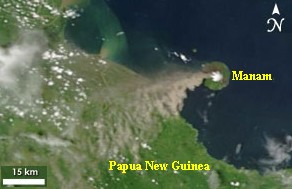 Manama
erupting on November 15, 2004, when the Moderate Resolution
Imaging Spectroradiometer (MODIS) flew overhead on NASA’s
Terra satellite. In this true-color image, dark ash rises
from the volcano and is drifting southwest over Papua
New Guinea.
NASA image courtesy Jacques Descloitres,
MODIS Rapid Response Team at NASA GSFC
Manama
erupting on November 15, 2004, when the Moderate Resolution
Imaging Spectroradiometer (MODIS) flew overhead on NASA’s
Terra satellite. In this true-color image, dark ash rises
from the volcano and is drifting southwest over Papua
New Guinea.
NASA image courtesy Jacques Descloitres,
MODIS Rapid Response Team at NASA GSFC |
Monday, November 29th, 2004
 November
28th, 18.00 local time
©RVO
November
28th, 18.00 local time
©RVO |
The following report has been received
from RVO for period of activity:
: 28th (08:00 a.m.) - 29th (06:00 a.m.) November 2004 (UTC -11
hrs)
The moderate eruptive activity from Main Crater that began after
1600hrs on 26th continued until 0600hrs
this morning (29th).
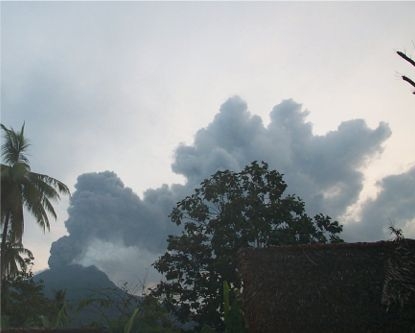 November
26th, 06.00 local time
©RVO
November
26th, 06.00 local time
©RVO |
The summit activity was similar as previously
reported. The ash clouds were rising less than a kilometer above
the summit before being blown to E-SE of the island. Occasional
fine ash fall was reported at Warisi during the reported period.
Weak roaring noises were heard only between 1900hrs (28th) and
0000hrs (29th). A weak glow with weak projections of incandescent
lava fragments was visible last night.
Southern Crater released thin white vapour only.
There was no noises heard. However, a weak glow was visible between
1900hrs (28th) and 0000hrs (29th).
Sunday, November 28th, 2004
The following report has been received from RVO for period
of activity:
27th (08:00 a.m.) - 28th (08:00 a.m.) November 2004
The slight increase in eruptive activity from Manam's Main
Crater that began after 1600hrs
on 26th continued until 0800hrs this morning (28th).
The eruptive activity consisted of continuous sub-forceful to
forceful emission of thick dark
grey ash clouds. The ash clouds were rising less than a kilometer
above the summit before
being blown by the shifting N-NE and N-NW winds. Fine ash fall
was reported at Warisi
early this morning. Only three weak roaring noises were heard
yesterday. Weak to bright
fluctuating glow was visible last night. Southern Crater released
thin white vapour only.
Excerpts from The
Age, Australia:
Hundreds of villagers were evacuated from the island after
claiming the lives of two people
who drank ash-contaminated water. The deaths of a woman and a
child on the island have
been blamed on the ash-contaminated water they drank.
An official with the Provincial Disaster Office in Madang province,
said a landing barge had
carried about 600 islanders from Manam Island to the mainland.
Ash had settled in some places two to three metres
deep and it would take a long time for
the vegetation to recover. Many islanders might not be able to
return for years and some
would have to be permanently resettled on the mainland.
Officials were finding tents for the evacuees
until they could build their own shelters.
The problem will be to get these people settled so they will be
able to look after themselves.
It is going to be a problem for the government to feed them for
some time, for six months or so.
Saturday, November 27th, 2004
We have received the following update from Rabaul Volcano
Observatory:
Period of activity: 26th (08:00 a.m.) - 27th (08:00 a.m.)
November 2004
(17.00 Thursday - 17.00 Friday GMT/UTC)
A slight increase in eruptive activity from Manam's Main Crater
began after 1600hrs
yesterday and continued until 0800hrs this morning (27th).
The summit activity consisted of continuous forceful
emission of thick dark grey ash clouds
that rose less than a kilometer above the summit before being
blown to the NW of the island.
Fine ash fall on the NW of the island at Zogari and Iassa villages
was reported from about
1700hrs LT. Only a single weak roaring noise was heard between
0600hrs and 0700hrs this
morning. Nil glow was visible last night. Southern Crater released
thin white vapour only.
Seismicity was at moderate to moderate high level from 2300hrs
and 0800hrs this morning.
Volcanic tremors continue to be recorded suggesting the system
is still dynamic and therefore
variable eruptive activity may continue to occur. Sporadic phases
of stronger eruptive activity
are also expected to occur.
Villagers near the four main valleys should remain away from them
as much as possible due
to unexpected rapid increase in activity. Also people should move
away from downwind
areas during an eruption to avoid scoria and ash fall. Furthermore
due to continuous ashfall
since 24th October and periods of light rainfall, mudflows may
occur. In addition, ash
loading on weak bush material houses may cause them to collapse.
Friday, November 26th, 2004
Latest: 12.00 Centr.Eu.time:
Madang Regional MP and Inter-Government Relations Minister flew
into the area in his
helicopter when he learnt of the eruption yesterday morning. The
Minister reported that the
entire side of the mountain for approximately one kilometre wide
blew out, with lava still
discharging into the sea between Warisi and Dugalava.
He said the eruption has subsided considerably when he returned
to Madang at 3pm
but it is still erupting with violent noise.
He said at Bien, he was hit with rocks in the helicopter which
have damaged his windscreen,
preventing him from getting around the island between Bien, Yassa,
Jorai and Tabele
which is the area being hit with most of the dust and rocks.
The
National
Red Cross and other international organizations are now sending
help to Papua New Guinea
to bring relief to the people on the island.
Manam evacuation
More than 9000 people from Manam Island will be evacuated
to the mainland starting today.
The evacuation will start with four villages in the north of the
island that are the most affected
by the increase in volcanic activity, causing heavier ash fall
and discharge of volcanic rocks.
The four villages are Kolang 1 and 2, Bokure, Abaria and Warisi.
Next to follow will be
Boda and Kuluguma, then villagers from Zogari, Yassa and Waia,
followed by Madauri and
Budua, Dangale, Baliau, Boisa Island and Dugulava. People in these
villages will be evacuated
to three care centres at Potsdam, Asuramba, Daigul and Mangen
plantations on the Bogia
coast. Daigul is planned to be the permanent settlement.
The ship is expected to make five trips across the passage. Disaster
officials yesterday met in
Madang to decide on the evacuation following renewed volcanic
activity. Although the alert is
still at stage 3 level, the disaster officials felt it was important
to evacuate the islanders as there
had been increased ash fall and rock discharge from the volcano.
Officials also fear mudflows
when the rain season sets in.
A medical team led by a doctor from the Modilon Hospital left
last night for Bogia to attend to people
suffering from diseases and injuries as a result of the volcanic
activity.
The Post Courier Online, Papua New Guinea
Thursday, November 25th, 2004
Voluntary evacuations have begun. The volcano has yesterday
coughed up lava and large
rocks. An aviation red alert was issued for aircraft to avoid
the area, with an ash plume
extending 130 km (80 miles) southeast of Manam.
The Manam people's food gardens and water sources have been severely
affected by the
continuous ash falls from the Manam volcano since October 24.
Hunger is setting in because
the islanders have lost their food gardens over the past month
.
Emergency officials said an area was being cleared on the mainland
for a possible full-scale evacuation of Manam's 9,600 islanders.
Evacuation becomes compulsory if volcanic activity intensifies
and reaches stage 4.
Some 20 bush homes have collapsed due to mud rain and five people
have been injured
Wednesday, November 24th, 2004
NEW eruptions from a volcano on Papua New Guinea's Manam Island
have prompted
authorities to raise the alert level and appeal for food and funds
for affected islanders.
Manam's main crater had thrown up a 10km-high
ash cloud and ejected glowing lava,
scientists at the Rabaul Volcanological Observatory said today.
A lava flow was also
reported to be heading for two villages on the island in Madang
Province.
The latest increase in activity following the
volcano's eruption on Oct. 24 prompted authorities
to raise the alert level to stage three, which allows voluntary
evacuations from the island.
Villages and crops have been covered in ash and villagers have
been warned to stay away
from the island's four main valleys and from downwind areas to
avoid scoria and ash falls
. At 1850 hrs LT, the 23rd, a phase of strong Strombolian eruption
began producing a
continuous thick ash column that rose about 10 km above the summit.
The ash cloud emissions
were accompanied by projection of glowing lava fragments, loud
roaring and rumbling noises,
and occasional loud and banging noises that produced shock waves.
A continuous bright red
glow visible down the NE valley indicated emplacement of a lava
flow. The lava flow was
reported heading towards Kolang and Bokure 1 villages.
Friday, November 12th, 2004
As of the 12th of November, the Global Volcanism Network (GVN)
has reported that
Manam volcano has re-erupted in Papua New Guinea. Ash emissions
reached 10.000 m
elevation 40 nautical miles W/NW of the volcano, and 7.000 m elevation
80 nautical miles
to SW, as of 0730 hr UTC on 11th November.
Monday, November 8th, 2004
The eruption that began at Manam on 24 October continued
through at least 31 October.
According to RVO, during 27-28 October there were occasional emissions
of ash-laden
brown clouds and projections of incandescent lava from Manam's
Southern Crater.
Fine ash from the eruptions traveled NW, and was deposited between
the villages of Jogari
and Baliau. Main Crater released occasional weak-to-moderate emissions
of white vapour,
and sometimes brown ash. Weak, fluctuating incandescence was visible
from the crater at
night.
 Observatory
and summit of Manam volcano.
From James
Mori's pages
Observatory
and summit of Manam volcano.
From James
Mori's pages |
During 28-29 October, at Southern Crater
there were occasional emissions of moderate,
thick, dark ash-laden clouds that rose above normal atmospheric
clouds. The ash clouds
drifted NW, depositing ash between the villages of Yassa and Baliau.
The Alert Level at
Manam was at Stage 1. By 31 October, the eruption at Main Crater
consisted of
Strombolian activity, with ash and scoria emissions. Scoria of
~1 cm diameter and ash was
deposited in Warisi village on the SE side of the island. Small
pyroclastic flows were
generated and fresh lava flowed into the NE valley. The lava flow
followed the Boakure side
of the valley, covering older flows from the 1992-1994 eruption.
Beginning on the morning
of the 31st, the amount of continuous volcanic tremor increased
to moderate-to-high levels,
so the Alert Level was increased to Stage 2. Villagers near the
four main valleys near Manam
were advised to remain away from the volcano.
The Darwin VAAC reported that a SE-drifting plume
from Manam was visible on satellite
imagery on 31 October during 0813-1449 at a height of ~13.7 km
a.s.l. The Aviation Colour
Code was at Red, the highest level. According to a news report,
about 4,000 villagers living
near the volcano were moved to safer areas. Reportedly, "about
1 ft [0.3 m] of ash with hot
pumice" landed on the roofs of houses, and ash drifted as
far W as Wewak, ~100 km from
Manam Island. On 2 November around 2325 a possible eruption may
have produced a
plume to a height of ~7.6 km a.s.l. that drifted SE.
As of 9:00 am LT this morning (Oct.24th) activity at Manam had
declined. Seismicity reflects
this decline. There was still a constant fall of fine ash to the
northwest around the Yasa and
Boda areas, from Boda to Baliau some heavier ashfall has occurred.
Scouria has fallen
around Yassa-NW valley and Boda.
Yesterday's pyroclastic flow destroyed gardens and coconut trees
at Warisi village.
The flow reached the sea and pumice rafts are present.
Four children from Dugulaba, (aged 1.5, 4, 6,
3) tried to canoe to Bogia to get away from the eruption.
They are missing; people on the ground are still looking. They
have been missing since the eruption.
(See our report: The Manam People and
the Eruption, red frame)
|
